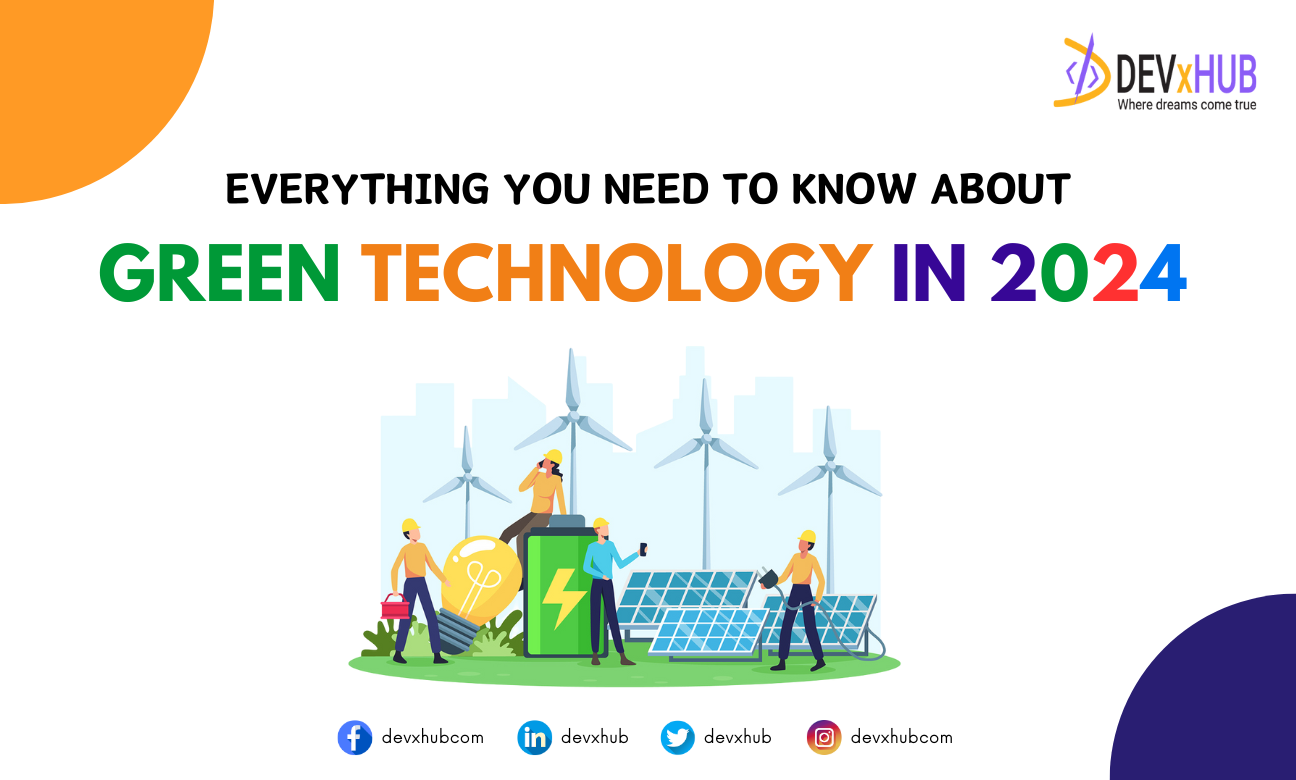Blog - Everything You Need to Know About Green Technology in 2024
In 2024, while green technology may seem like the latest trend, its roots run deep in history, showcasing a rich tapestry of sustainable innovation.
Consider geothermal heating, a modern favorite for energy-efficient spaces. Its origins trace back to Paleolithic times, where our ancestors tapped into the earth’s warmth, bathing in hot springs and even crafting dwellings from volcanic materials. Wind energy, another pillar of sustainability, has ancient roots dating as far back as 5000 B.C. when early civilizations utilized wind power to navigate the River Nile. By 2000 B.C., windmills were already in use, pumping water and grinding grains. Solar power, too, boasts an ancient legacy, with humans harnessing the sun’s rays as early as the 7th century B.C. to ignite fires using magnifying glasses.
Even the concept of battery-powered vehicles, often seen as a modern innovation, has roots in history. Surprisingly, at the dawn of the 19th century, electric vehicles accounted for a staggering 90% of New York City’s taxi fleet, demonstrating that the idea of clean transportation is not as new as it may seem.
So humans have been working on sustainable solutions for everyday needs for a long time. But today, innovative solutions to our environmental problems is now more popular — and more necessary — than ever.
What does green technology actually mean ?
In a nutshell, green technology is any technology designed to reduce the negative impact of human activity on the environment.
Green Technology: A Variety of Examples
Green technology encompasses more than just solar panels and wind turbines. Here’s a compilation of some lesser-known yet impactful innovations aimed at preserving our planet:
- Wastewater treatment and water purification: Recycling water to render it potable or suitable for other purposes.
- Waste management and recycling: Minimizing landfill usage and its environmental repercussions.
- Waste-to-energy: Converting landfill waste into electricity through combustion.
- Electric transportation: Including electric cars, trucks, buses, and scooters.
- Programmable thermostats: Adjusting temperatures to conserve energy during periods of absence.
- Self-sufficient buildings: Structures equipped to generate their own power, often through solar panels.
- Low-carbon construction: Creating energy-efficient buildings using eco-friendly materials and minimal space.
- Carbon capture and storage: Removing carbon dioxide from the atmosphere for storage or utilization.
- LED lighting: Employing ultra-energy-efficient light bulbs for reduced electricity consumption.
- Vertical farming: Utilizing compact setups in urban areas for agriculture, requiring less land and water.
- Composting: Transforming food waste into nutrient-rich fertilizer.
- Wave energy: Harnessing ocean waves to produce electricity.
- Batteries: Crucial for storing energy in the transition to renewable sources.
- Green materials: Utilizing renewable and locally-sourced resources like bamboo, hemp, and straw.
- Carbon tracking software: Tools for calculating a company’s carbon emissions, aiding in sustainability efforts.
5 Green Tech Trends to Monitor in 2024
Low-Carbon Construction
The rise of smart, sustainable buildings is notable as traditional construction contributes to a staggering 38% of global greenhouse gas emissions. Low-carbon buildings, engineered to emit minimal carbon throughout their lifecycle, are gaining traction. They boast efficient heating and cooling systems, produce minimal waste and pollution, and utilize eco-friendly materials such as bamboo and hemp. Many are self-sufficient, generating their own energy through rooftop solar panels, making them indispensable for a greener future.
Carbon Capture and Storage
While carbon offsets are a step in the right direction, they alone cannot limit global temperature rise to below 1.5°C. To achieve this, we must actively remove carbon from the atmosphere. Carbon capture and storage technology extracts carbon from the air, converting it into synthetic fuel. Although currently costly and limited in scale, studies, such as one from Stanford University, suggest that costs could decrease significantly, potentially making this technology more scalable.
Renewable Energy Storage
A major challenge in transitioning to renewables is ensuring consistent energy availability, regardless of weather conditions. Long-term energy storage solutions are essential for storing surplus energy during peak production periods. Companies like Aquion Energy, Malta (Google X), and Highview Power are pioneering innovative storage solutions to address this need, facilitating the widespread adoption of renewable energy sources.
Hydrogen
Fuel cell electric vehicles, powered by hydrogen instead of traditional batteries, offer a promising alternative to combustion-powered vehicles. Hydrogen vehicles are more efficient and emit no harmful emissions. Forecasts suggest that hydrogen could power millions of vehicles and even a significant portion of maritime transport by 2050. Despite the current expense, hydrogen-powered vehicles are gaining traction globally and could play a pivotal role in reducing transport emissions.
Upcycling (Circular Waste Management)
Upcycling, the process of converting waste into new materials or products, is gaining momentum worldwide. Innovative companies and organizations are repurposing waste into valuable resources, ranging from fuel and fertilizer to clothing and bicycles.
Defining Green Technology
Green technology, also known as cleantech or environmental technology, applies scientific and technological innovations to develop eco-friendly products and services. It aims to reduce environmental harm, repair damage, and promote sustainability across various sectors, from renewable energy to waste management.
Differentiating Green Tech, Clean Tech, and Environmental Tech
While green tech, clean tech, and environmental tech are often used interchangeably, they each have distinct focuses within the realm of sustainability. Green technology encompasses any technology that prioritizes environmental friendliness and sustainability, aiming to reduce overall human impact on the environment. Clean tech, on the other hand, concentrates on improving environmental performance, often by enhancing the efficiency and eco-friendliness of production processes. Environmental tech, sometimes known as climate tech, specifically targets issues related to human-induced climate change, such as reducing greenhouse gas emissions or adapting to the consequences of a changing climate.
Understanding these nuances helps in appreciating the diverse range of solutions offered by green, clean, and environmental technologies in addressing the multifaceted challenges confronting our planet.
The Evolution of Green Technology
The history of green technology stretches back further than one might expect, with roots tracing back to the era of the Great Depression. Initiatives such as the Soil Conservation Act of 1935, established in response to the devastating Dust Bowl, marked early efforts to address environmental challenges through policy and action. The formalization of environmental protection gained momentum with the establishment of the Environmental Protection Agency (EPA) in 1970, reflecting increasing public awareness and concern for environmental issues following World War II.
The evolution of green technology gained traction as scientists began recognizing the environmental impacts of industrial activities, particularly those related to fossil fuel consumption, in the early 1990s. Since then, fueled by social movements, advocacy organizations, and governmental policies promoting sustainable development, the sector has continually evolved. This journey highlights the adaptive and responsive nature of green technology in addressing environmental crises and advancing sustainable solutions.
Modern green technology encompasses a wide array of innovative solutions, ranging from renewable energy sources like solar and wind power to advanced waste management and recycling systems. As public awareness of environmental issues continues to grow, so does the demand for green tech, driving further advancements and adoption across industries.
Categories and Examples of Green Tech
Green technology can be broadly categorized into several key areas, each playing a crucial role in minimizing human impact on the environment and promoting sustainability:
- Renewable Energy Sources: Technologies such as solar power, wind turbines, and geothermal energy systems harness natural elements to generate clean electricity, reducing reliance on fossil fuels and mitigating greenhouse gas emissions.
- Sustainable Transportation: Innovations in sustainable transportation, including electric vehicles (EVs), hydrogen fuel cell vehicles, and public transit systems powered by renewable energy, offer eco-friendly alternatives to traditional gasoline-powered vehicles, reducing emissions and congestion.
- Waste Management and Recycling: Advanced waste management technologies, such as material recovery facilities (MRFs), composting systems, and anaerobic digesters, facilitate the diversion of waste from landfills and promote resource recovery through recycling, composting, and energy generation from organic waste.
- Energy Efficiency Solutions: Energy-efficient technologies, such as smart thermostats, LED lighting, and high-performance building materials, help reduce energy consumption and greenhouse gas emissions in residential, commercial, and industrial settings, contributing to overall sustainability efforts.
These categories encompass a diverse range of green technologies, each with its unique set of examples and applications, contributing to a more sustainable and environmentally friendly future.
Ethical Considerations and Investment in Green Tech
The implementation of green technology entails careful consideration of various ethical considerations, including fairness, inclusivity, and the minimization of negative impacts on communities and ecosystems. It is essential to ensure that the benefits of green technology are accessible to all individuals and communities, promoting social justice and equity.
Moreover, the potential repercussions of green technology on communities and ecosystems must be carefully evaluated and addressed to prevent unintended environmental harm or disruption of local cultures. By adopting a holistic approach to sustainability, green technology can deliver benefits for both people and the planet, integrating ethical considerations into its implementation and operation.
In terms of investment, there are numerous options available for those interested in supporting the growth of green technology. Investors can choose to invest in companies dedicated to developing and implementing environmentally friendly technologies, select individual stocks within the green tech sector, or invest in mutual funds or exchange-traded funds (ETFs) focused on environmental and sustainable investments.
By financially supporting green technology initiatives, individuals and institutions can contribute to the development and adoption of sustainable solutions, helping to address environmental challenges and promote a more eco-friendly future.
Green Tech Trends and Future Outlook
The future of technology is undeniably green, with transformative trends and exciting developments continually emerging. The ultimate goal is for green technology to transition from a separate, specialized field into the cornerstone of all technological innovation. A future where green technology is simply “business as usual” represents the optimal scenario.
Currently, trends like low-carbon construction, carbon capture and storage, renewable energy storage, hydrogen fuel, and upcycling are leading the way. Renewable energy sources, such as solar, wind, geothermal, and hydropower, are evolving and becoming increasingly efficient and accessible alternatives to conventional energy sources.
The push towards plastic elimination is significant, aiming to reduce plastic usage in products and packaging to minimize pollution and waste. However, the journey extends beyond adopting green technology. The ultimate goal is transitioning from merely reducing emissions to creating regenerative businesses.
Summary
green technology offers a wide range of innovative solutions geared towards lessening human impact on the environment, conserving resources, and fostering sustainability. From renewable energy and sustainable transportation to waste management and energy efficiency, these technologies hold promise for transforming industries and shaping a cleaner, greener future. Through investments in green technology, advocacy for supportive government policies, and individual efforts to reduce our environmental footprint, we can all play a part in building a more sustainable world and safeguarding the planet for future generations.
Related Posts
Categories
- App Development (2)
- Design (2)
- DEVxHUB (30)
- Digital Marketing (2)
- Guide (24)
- It Bangladesh (1)
- Logo design (1)
- Operating system (1)
- Personal Improvement (14)
- Planning (4)
- Project management (3)
- Social media (2)
- Software Development (5)
- Software Quality Assurance (8)
- Startups (1)
- Team work (1)
- UI UX (1)
- Web Development (6)
Main Tags
- 2024
- Android
- app development
- bangladesh
- content writing
- design
- devxhub
- Digital marketing
- Guide
- IOS
- It
- logo design
- Operating system
- Personal Improvement
- planning
- project management
- social media
- Software Development
- Software Quality Assurance
- software testing
- software testing types
- Startups
- Success
- team
- UI UX
- UI UX design
- VR
- Web Development















